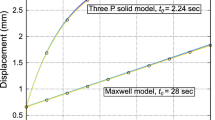Abstract
This article describes an original and multipurpose experimental set-up for the analysis of complex linear and non-linear aspects of aero-elastic behaviour of beam cross-sections. The apparatus meets rigorous theoretical assumptions and allows very precise and quick adjustment of stiffness and mass of a cross-section, which is not always possible with the traditional “parallel spring-supported bridge” approach used by many researchers. The principal advantages are described together with key construction details. Examples of the large amplitude non-linear response are presented, to illustrate the capacity and usefulness of the stand.
Similar content being viewed by others
References
Parkinson, G.V., “Phenomena and Modelling of Flow-Induced Vibrations of Bluff Bodies,” Progress in Aerospace Sciences 26(2):169–224 (1989).
Naudasher, E., and Rockwell, D., Flow-Induced Vibrations -An Engineering Guide, Balkema, Rotterdam (1996).
Scott, R., In the Wake of Tacoma: Suspension Bridges and the Quest for Aerodynamic Stability, ASCE Press, Reston, VA (2001).
Billah, Y.K., and Scanlan, R.H., “Resonance, Tacoma Narrows Bridge Failure, and Undergraduate Physics Textbooks,” American Journal of Physics 59(2):118–124 (1991).
Scruton, C., “On the Wind Excited Oscillation of Stacks, Towers and Masts,” Proceeding, International Conference on Wind Effects on Buildings and Structures, London, UK, pp. 798–836 (1963).
Novák, M., and Davenport, A.G., “Aero-Elastic Instability of Prism in Turbulent Flow,” Journal of Engineering Mechanics Division ASCE 96:17–39 (1970).
Neuhaus, C., Roesler, S., Höffer, R., Hortmanns, M., Zahlten, W., “Identification of 18 Flutter Derivatives By Forced Vibration Tests - A New Experimental Rig,” Proceeding paper of IACWE 5, No. 126, Florence, Italy, (2009).
Sarkic, A., Fisch, R., Höffer, R., and Bletzinger, K.-U., “Bridge Flutter Derivatives Based on Computed, Validated Pressure Fields,” Journal of Wind Engineering and Industrial Aerodynamics 104–106:141–151 (2012).
Kloeppel, K., and Thiele, F., “Modellversuche im Windkanal zur Bemessung von Bruecken gegen Gefahr winderregter Schwingungen,” Der Stahlbau 36(12):353–365 (1967).
Sato, H., Hirahara, N., Fumoto, K., Hirano, S., and Kusuhara, S., “Full Aero-Elastic Model Test of Super Long-Span Bridge with Slotted Box Girder,” Journal of Wind Engineering and Industrial Aerodynamics 90:2023–2032 (2002).
O’Neil T., “Non-Linear Aero-Elastic Response - Analyses and Experiments,” AIAA Meeting Paper 96–0014, (1996).
Noda, M., Utsunomiya, H., Nagao, F., Kanda, M., and Shiraishi, N., “Effects of oscillation amplitude on aerodynamic derivatives,” Journal of Wind Engineering and Industrial Aerodynamics 91:101–111 (2003).
Larsen, A., “Advances in Aero-Elastic Analyses of Suspension and Cable-Stayed Bridges,” Journal of Wind Engineering and Industrial Aerodynamics 74–76:73–90 (1998).
Sarkar, P., Caracoglia, L., Haan, F.L., Sato, H., and Murakoshi, J., “Comparative and Sensitivity Study of Flutter Derivatives of Selected Bridge Deck Sections, Part 1: Analysis of Inter-Laboratory Experimental Data,” Engineering Structures 31:158–169 (2009).
Hjorth-Hansen, E., “Section Model Test,” Proceedings, Aerodynamics of Large Bridges, Balkema, Rotterdam, pp. 95–113 (1992).
Sarkar, P.P., Chowdhury, A.G., and Gardner, T.B., “A Novel Elastic Suspension System for Wind Tunnel Section Model Studies,” Journal of Wind Engineering and Industrial Aerodynamics 92:23–40 (2004).
Jain, A., Jones, N.P., and Scanlan, R.H., “Coupled Aero-Elastic and Aerodynamic Response Analysis of Long-Span Bridge,” Journal of Wind Engineering and Industrial Aerodynamics 70:69–80 (1996).
Chowdhury, A.G., and Sarkar, P.P., “A New Technique for Identification of Eighteen Flutter Derivatives Using a Three-Degree-of-Freedom Section Model,” Engineering Structures 25(14):1763–1772 (2003).
Scanlan, R.H., “The Action of Flexible Bridges Under Wind, I: Flutter Theory,” Journal of Sound and Vibration 60(2):187–199 (1978a).
Scanlan, R.H., “The Action of Flexible Bridges Under Wind, II: Buffeting Theory,” Journal of Sound and Vibration 60(2):201–211 (1978b).
Focken, C.M., Dimensional Methods and Their Application, Arnold, London (1953).
Koloušek, V., Pirner, M., Fischer, O., and Náprstek, J., Wind Effect on Civil Engineering Structures, Elsevier, Amsterdam (1983).
Matsumoto, M., “Aerodynamic Damping of Prisms,” Journal of Wind Engineering and Industrial Aerodynamics 59:159–175 (1996).
Cao, B., and Sarkar, P.P., “Identification of Rational Functions Using Two-Degree-of-Freedom Model by Forced Vibration Method,” Engineering structures 43:21–30 (2012).
Durley, R.J., Kinematics of Machines, Wiley, New York (1907).
O’Neil, T.G., and Strganac, T.W., “An Experimental Investigation of Nonlinear Aeroelastic Response,” AIAA Journal of Aircraft 35(4):616–622 (1998).
Gu, M., Zhang, R., and Xiang, M., “Identification of Flutter Derivatives of Bridge Decks,” Journal of Wind Engineering and Industrial Aerodynamics 84:151–162 (2000).
Král R., Pospíšil, S., Náprstek, J., “Response of Bluff and Streamlined Bridge Girder in the Wind as Function of Natural Frequency Tuning,” Proceeding, 5-th European & African Conference on Wind Engineering, Florence, Italy, pp. 309–312, (2009).
Král, R., Pospíšil, S., Náprstek, J., “Experimental Analysis of Frequency Tuning Influence on the Response Stability of Bridge Girders Under Wind Action,” Proceeding, 13th International Conference on Wind Engineering, Amsterdam, The Netherlands, (2011).
Larsen, A., and Walther, J., “Discrete Vortex Simulation of Flow Around Five Generic Bridge Deck Sections,” Journal of Wind Engineering and Industrial Aerodynamics 77–78:591–602 (1998).
Frandsen, J.B., “Simultaneous Pressures and Accelerations Measured Full-Scale on the Great Belt East Suspension Bridge,” Journal of Wind Engineering and Industrial Aerodynamics 89:95–129 (2001).
Author information
Authors and Affiliations
Corresponding author
Rights and permissions
About this article
Cite this article
Král, R., Pospíšil, S. & Náprstek, J. Experimental Set-Up for Advanced Aeroelastic Tests on Sectional Models. Exp Tech 40, 3–13 (2016). https://doi.org/10.1007/s40799-015-0004-6
Received:
Accepted:
Published:
Issue Date:
DOI: https://doi.org/10.1007/s40799-015-0004-6




